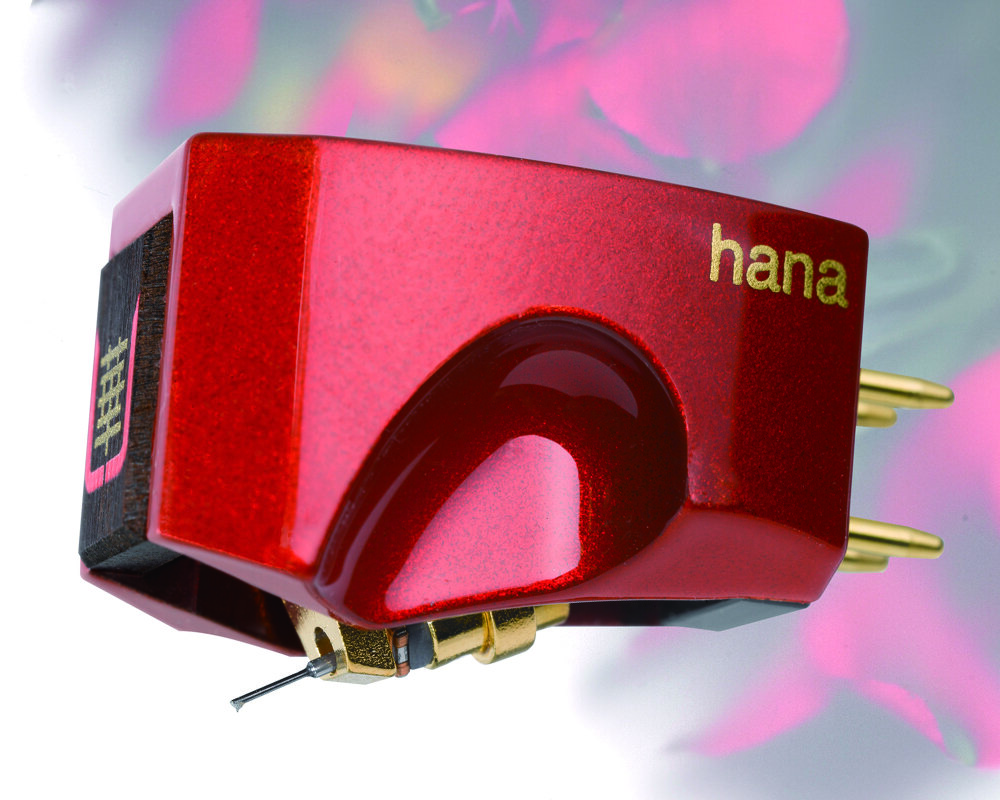A proper Japanese translation of the word umami is the “essence of deliciousness”. Still another suggests the literal translation to be a “pleasant, savory taste”. These definitions apply to the Hana Umami Red moving coil phono cartridge, which is not only a real treat to hear, but is also a treat for your wallet at the MSRP of only $3950. “Only” almost four grand? That ain’t chicken feed, as the saying goes. But YES to “only”, as in a bargain, and I’ll tell you why in a minute.
Musical Surroundings is the US distributor for the line of Hana cartridges, which includes the Hana ML, EL, SH, SL, EH, Umami Blue and Umami Red. Hana, which translates as “brilliant and gorgeous”, is relatively new to the American marketplace. Hana is attracting a lot of attention due to aggressive pricing, expansive product range, and excellent sound.
Musical Surroundings is also a manufacturer, offering the newly redesigned Phonomena III phono preamplifier. From the MS Website:
“The Phonomena phono stage, in production since 1999, has been continuously improved throughout the years. The basic concept has remained unchanged: discrete circuitry that provides flexible gain and loading to maximize the performance of both MM and MC phono cartridges.”
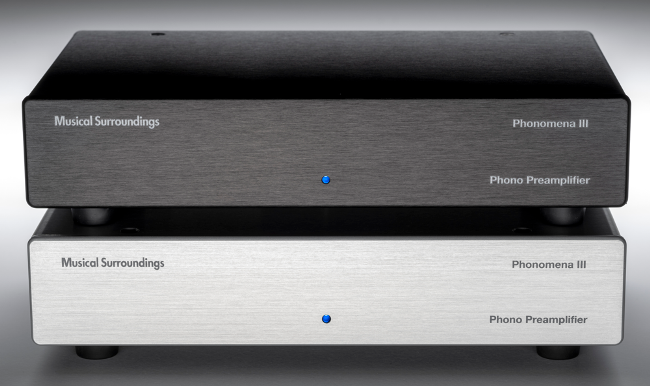
The Musical Surroundings Phonomena III phono preamplifier, $1200, is made in California. It offers up to 66 dB of gain, many settings for gain and loading, and matched input transistors. The resistive loading options, selected from DIP switches on the rear panel, include 17 settings from 30 to 100k Ohms. There are 15 settings for gain from 40 to 66 dB. These numerous settings should accommodate any cartridge and required system gain in use today.
A sonic upgrade for the Phonomena III is the optional Linear Power Supply, $1000, which comes in an enclosure just 8.5” x 6” x 2” and is the same size as the phono stage and also weighs the same at 3 pounds. The external Linear Power Supply replaces the small “wall wart” supply which is included as standard equipment with the preamplifier. A 3-year warranty is also standard.
The review system includes an Acoustic Signature Montana Neo turntable with both Acoustic Signature TA-7000 Neo and Origin Live Agile tonearms. Phono cartridges included a ZYX UNIverse Optimum, Miyajima Destiny, and Tzar DST, all moving coil cartridges. Phono preamplifiers in recent memory include a CH Precision P1-X1, Simaudio Moon 810LP, Sutherland TZ Direct, BMC MCCI ULN, and Aurorasound VIDA Prima.
The Umami Red is constructed from Urushi lacquered CNC machined Duralumin, ebony wood insert, and Samarium Cobalt magnets. The cantilever is boron, and coils are wired with high purity copper. The coil impedance is 6 Ohms and the output is a healthy 0.4 mV.
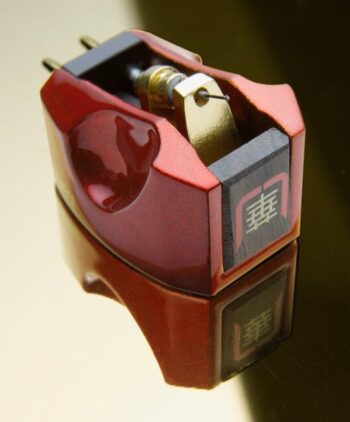 The Umami Red cartridge was given 100 hours of break in using the Cardas Frequency Sweep and Burn In Record’s locked grooves. I would alternate between the horizontal and vertical grooves for several hours each, cleaning the stylus before changing the groove. I had a brief listen to the new components, and it was easy to recognize the improvements in clean resolution across the audible frequency range when the burn in interval was complete. After this interval, optimum loading was found to be 380 Ohms. This setting offers very extended, clean and clear upper treble without glare from too low (higher resistance values) loading. The optimum cartridge loading can be listener and system specific because what one setting gives in upper frequency air and detail in one system could be heard as overly bright or forward in a different system.
The Umami Red cartridge was given 100 hours of break in using the Cardas Frequency Sweep and Burn In Record’s locked grooves. I would alternate between the horizontal and vertical grooves for several hours each, cleaning the stylus before changing the groove. I had a brief listen to the new components, and it was easy to recognize the improvements in clean resolution across the audible frequency range when the burn in interval was complete. After this interval, optimum loading was found to be 380 Ohms. This setting offers very extended, clean and clear upper treble without glare from too low (higher resistance values) loading. The optimum cartridge loading can be listener and system specific because what one setting gives in upper frequency air and detail in one system could be heard as overly bright or forward in a different system.
Gain was set at 54 dB, which provides a similar output level to the Bricasti M1 Series 2 DAC. There might have been a slight increase in midrange weight when the gain was reduced from 60 dB to 54 dB.
The first listen to the Umami Red and Phonomena III, before break in, showed a promising performance, with the bass a little loose and good extension in the treble, if a bit harsh. These qualities are very common in new gear of any type. Thankfully, these small demerits were greatly ameliorated by the 10-hour mark, and continued to slowly improve. The final result was definitely worth the wait. My notes say, “At 100 hours, these babies are makin’ music!”
The combination has excellent articulation and response to very small details buried deep in the record groove. The midrange is very clean and linear with no sense of separate bass, midrange or treble. Music just flows freely across the musical spectrum. This linearity is a strength of this pairing of cartridge and phono preamplifier. Linearity is one of two must-have requirements for acceptable music reproduction. The other is resolution. A music system must be linear from low bass to upper treble, with no highlighting or emphasis in any narrow frequency range. The system must also deliver the same quality and quantity of resolution across the frequency range. Linearity plus resolution are keys to a satisfying audio system.
The Red-Phonomena combo is quite satisfactory, delivering the music in a natural and involving manner. The soundstage is wide and nicely deep, although the height dimension is limited. The external Linear Power Supply (LPS) definitely improved low level resolution, size of the sound stage, and naturalness of singers. While not mandatory, the Linear Power Supply is a very worthwhile upgrade and increases the Phonomena III’s sound quality noticeably. The overall sound quality of the Phonomena III with LPS is roughly similar to the slightly more forward-sounding Aurorasound VIDA Prima. If not purchased with the Phonomena III, the LPS is a recommended upgrade path.
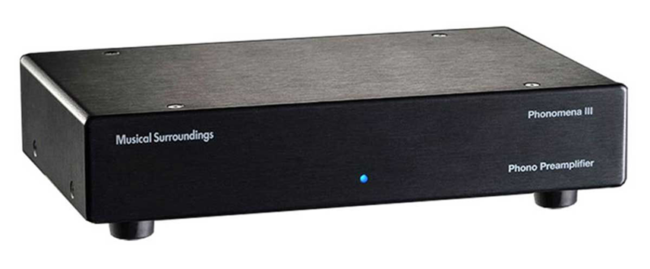
What was the result when the Umami Red was connected to the $54,000 CH Precision P1 phono preamplifier with X1 power supply? Folks want to know how the Umami Red stands on its own, right? I wouldn’t be a bit surprised if the importer reads the following comments and immediately understands that the phono cartridge is priced totally wrong. I mean, components are priced based on COGS – cost of goods sold, including overhead, marketing, and other costs. Maybe the Red’s price, at $3,950, covers those accounting items. What seems to have been totally missed in this suggested retail price is the competition. Friends, there “ain’t” any! Not at this price. You think I’m being overly dramatic? Think again!
Listening to the Umami Red through the P1, with loading at the same 380 Ohms that was set with the Phonomena III, I was repeatedly reminded of the Koetsu Rosewood Signature Platinum. At least for the wonderful Koetsu midrange. The Red has that quality of humanness in the midrange and adds a level of tighter and higher resolution bass. But more importantly, the Red delivers the extended and detailed resolution in the treble that the Koetsu minimizes. The result is a great feeling of immersion in the music, with less sense of the technology and more truth. If you find the Koetsu RSP deficient, try the Umami Red.
The excellent midrange delivers all vocals more intelligibly which is helped by a very clear lower treble. At the other end of the music spectrum, the bass is thunderous and delivers outstanding power and articulation into the lowest registers. The overall resolution is quite remarkable, and not only for the Red’s price. The distinctive voice of Joan Armatrading, a long-term favorite artist here at 10 Audio, is delivered with depth of tone that is immensely satisfying. Her voice just floats in air, very natural sounding and correct.
The Umami Red also delivers outstanding micro-dynamics, making it easy to hear a drumstick make initial contact with a drum head or cymbal. This contributes to truly excellent piano tone which is spot on. You will know when a piano’s sustain pedal is used to expand harmonics and depth.
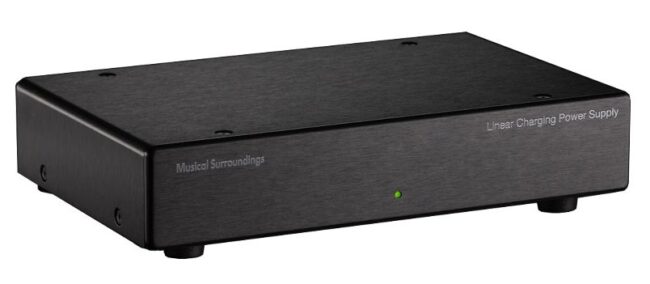
Listen to Michael Ruff’s “Watching Like Angels”, on the Speaking in Melodies LP, Sheffield Labs TLP35-HQ. There is great finesse, pure music, powerful and deep bass, and clear and correct upper frequencies without any glare or harshness. Again, the renowned Koetsu-like midrange is present, but with large improvements in both the bass and treble ends of the audio band.
Donald Fagan’s vocals on “The Goodbye Look” on the Nightfly LP, Warner Brothers 23696, from 1982, is very rich and human sounding. The cymbals on this cut are very correct with excellent micro-dynamic impact, deep into the LP groove. The bass in “Walk Between Raindrops” is outstanding, and fully apparent as it slowly steps up and down the scale. The Umami Red-CH Precision P1 is a wonderful pairing with each enhancing the other’s abilities.
These observations are of the Red connected to the MM/MC voltage input of the P1. The Phonomena also has a voltage input. Let’s move the cables over to one of the current inputs and see if there is an improvement. The current input has been found to offer performance increases on some moving coil cartridges, but not all. In this case, there is a reduction in midrange warmth and depth. The harmonics in the upper midrange and lower treble sound slightly emaciated compared to the voltage input with its loading set at 380 Ohms. The upper treble can sound brittle and cold. A My Sonic Lab Signature Platinum phono cartridge also preferred the P1’s voltage input, while both the Tzar DST and the ZYX Optimum cartridges love the current input.
This sonic character leans in the direction of what some folks call “transparency”. I define transparency as unlimited resolution and perfect linearity. The ZYX Optimum pulls a bit more detail from the vinyl groove, giving cymbals a bit more sizzle and sheen, but the Umami’s richer presentation is seemingly complete. There is no lack of air and ambiance. The bass is more than just very good.
If you want to blow your mind, and maybe a woofer, listen to The Manhattan Transfer’s recording of “Coo Coo U”, on their Extensions LP, MFSL 1-199. Incredible! If this cut doesn’t get your attention, you might be dead.
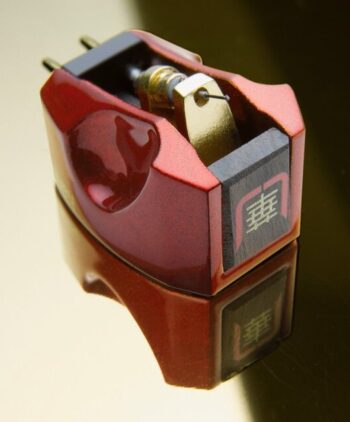 Let’s get back to a discussion of the Umami Red together with the Phonomena III. Part of the presentation of these two analog products is a nicely formed sound stage with excellent clarity of vocals. This is a real treat when listening to vocal groups as each singer maintains their individual presence and character. The 1972 pressing of NRPS – New Riders of the Purple Sage – Gypsy Cowboy LP, Columbia KC31930, is excellent, highlighting the outstanding performances on “She’s No Angel” and “Gypsy Cowboy”. Besides the vocals, cymbals have a remarkably accurate metallic sound.
Let’s get back to a discussion of the Umami Red together with the Phonomena III. Part of the presentation of these two analog products is a nicely formed sound stage with excellent clarity of vocals. This is a real treat when listening to vocal groups as each singer maintains their individual presence and character. The 1972 pressing of NRPS – New Riders of the Purple Sage – Gypsy Cowboy LP, Columbia KC31930, is excellent, highlighting the outstanding performances on “She’s No Angel” and “Gypsy Cowboy”. Besides the vocals, cymbals have a remarkably accurate metallic sound.
This combination seems to do everything right, although perfectly downsized for price. The main strength is an extremely even and balanced sound where nothing stands out due to the absence of spotlighting certain frequencies or from uneven resolution. The high frequencies have plenty of extension and presence, and the delivery of ethereal air supports the physical space of the recording venue. Imagine a piece of music on an exceptional system. You hear infinite resolution, achingly pure high frequencies, thunderous bass and a virtual reality-level of production of human voices. Now turn down the volume. While not actually lower in level, you get basically the same sound, just reduced in dynamics and some low-level detail is reduced in presence. However, the musical message comes through unambiguously.
The Umami Red seems to get the maximum possible performance from the Phonomena III preamplifier. Vocal clarity is near reference quality. Together, they offer all-around excellent performance.
Hana Umami Red – Overall Rating: 10 LPs

Musical Surroundings Phonomena III – Overall Rating: 8.5 LPs
Link to US distributor: Musical Surroundings
This review would not have been possible without the kind support from Garth Leerer at Musical Surroundings. Thank you, Garth!

